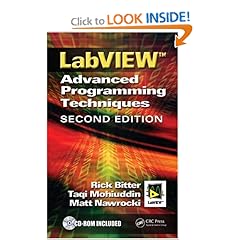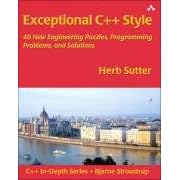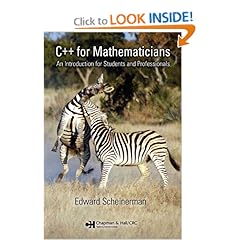LabVIEW Advanced Programming Techniques, 2nd Edition

LabVIEW™ Advanced Programming Techniques
SECOND EDITION
by : Rick Bitter, Taqi Mohiuddin, Matt Nawrocki
As the power of the standard personal computer has steadily evolved, so have the capabilities of LabVIEW. LabVIEW has simplified the working lives of thousands of scientists, engineers, and technicians, and has increased their productivity. Automation has reduced the costs and increased the manufacturing outputs of factories around the world. Cycle times for product development have been shortened and quality of many products has steadily improved. LabVIEW does not get credit for all of these improvements, but has without question played a valuable role in many organizations for accomplishing these goals.
The chapters in this book are written in a manner that will allow readers to study the topic of interest without having to read the contents in sequential order. Users of LabVIEW with varying levels of expertise will find this book beneficial.
Download :
LabVIEW Advanced Programming Techniques Part-1, Part-2
Read More......
Label: electronic, engineering, programming
Image Acquisition and Processing with LabVIEW

Image Acquisition and Processing with LabVIEW fills a hole in the LabVIEW technical publication range. It is intended for competent LabVIEW programmers, as a general training manual for those new to National Instruments’ (NI) Vision application development and a reference for more-experienced vision programmers.
It is assumed that readers have attained programming knowledge comparable to that taught in the NI LabVIEW Basics II course (see http://www.ni.com/training for a detailed course outline). The book covers introductions and theory of general image acquisition and processing topics, while providing more in-depth discussions and examples of speciÞc NI Vision tools.
This book is a comprehensive IMAQ and Vision resource combining reference material, theory on image processing techniques, information on how LabVIEW and the NI Vision toolkit handle each technique, examples of each of their uses and realworld case studies, all in one book.
Download :
Image Acquisition and Processing with LabVIEW PART_1, PART_2
Read More......
Label: engineering, programming
Exceptional C++ Style 40 New Engineering Puzzles

Exceptional C++ Style 40 New Engineering Puzzles, Programming Problems, and Solutions
By Herb Sutter
Publisher : Addison Wesley
Pub Date : August 02, 2004
ISBN : 0-201-76042-8
Pages : 352
Preface
Style or Substance?
The Exceptional Socrates
What I Assume You Know
How to Read This Book
The Topic of This Item
Acknowledgments
Generic Programming and the C++ Standard Library
Chapter 1. Uses and Abuses of vector
Chapter 2. The String Formatters of Manor Farm, Part 1: sprintf
Chapter 3. The String Formatters of Manor Farm, Part 2: Standard (or Blindingly Elegant) Alternatives
Chapter 4. Standard Library Member Functions
Chapter 5. Flavors of Genericity, Part 1: Covering the Basis [sic]
Chapter 6. Flavors of Genericity, Part 2: Generic Enough?
Chapter 7. Why Not Specialize Function Templates?
Chapter 8. Befriending Templates
Chapter 9. Export Restrictions, Part 1: Fundamentals
A Tale of Two Models
Illustrating the Issues
Export InAction [sic]
Issue the First: Source Exposure
Issue the Second: Dependencies and Build Times
Summary
Chapter 10. Export Restrictions, Part 2: Interactions, Usability Issues, and Guidelines
Exception Safety Issues and Techniques
Chapter 11. Try and Catch Me
Chapter 12. Exception Safety: Is It Worth It?
Chapter 13. A Pragmatic Look at Exception Specifications
Class Design, Inheritance, and Polymorphism
Chapter 14. Order, Order!
Chapter 15. Uses and Abuses of Access Rights
Chapter 16. (Mostly) Private
Chapter 17. Encapsulation
Chapter 18. Virtuality
Chapter 19. Enforcing Rules for Derived Classes
Memory and Resource Management
Chapter 20. Containers in Memory, Part 1: Levels of Memory Management
Chapter 21. Containers in Memory, Part 2: How Big Is It Really?
Chapter 22. To new, Perchance to throw, Part 1: The Many Faces of new
In-Place, Plain, and Nothrow new
Class-Specific new
A Name-Hiding Surprise
Summary
Chapter 23. To new, Perchance to throw, Part 2: Pragmatic Issues in Memory Management
Optimization and Efficiency
Chapter 24. Constant Optimization?
Chapter 25. inline Redux
Chapter 26. Data Formats and Efficiency, Part 1: When Compression Is the Name of the Game
Chapter 27. Data Formats and Efficiency, Part 2: (Even Less) Bit-Twiddling
Traps, Pitfalls, and Puzzlers
Chapter 28. Keywords That Aren't (or, Comments by Another Name)
Chapter 29. Is It Initialization?
Chapter 30. double or Nothing
Chapter 31. Amok Code
Chapter 32. Slight Typos? Graphic Language and Other Curiosities
Chapter 33. Operators, Operators Everywhere
Style Case Studies
Chapter 34. Index Tables
Chapter 35. Generic Callbacks
Chapter 36. Construction Unions
Chapter 37. Monoliths "Unstrung," Part 1: A Look at std::string
Chapter 38. Monoliths "Unstrung," Part 2: Refactoring std::string
Chapter 39. Monoliths "Unstrung," Part 3: std::string Diminishing
Chapter 40. Monoliths "Unstrung," Part 4: std::string Redux
Download :
Exceptional C++ Style 40 New Engineering Puzzles
Read More......
Label: programming
Practical Statecharts in C/C++−Quantum

Practical Statecharts in C/C++ − Quantum Programming for Embedded Systems
Miro Samek, Ph.D.
CMP Books
This book is intended for the following computer professionals interested in reactive, or event−driven, systems. Embedded programmers and consultants will find practical advice, explanations, and plenty of code that they can use as is or modify to build event−driven software.
- Real−time systems designers will find a lightweight
- alternative to heavyweight CASE tools formodeling real−time systems. The Quantum Framework, combined with a preemptive RTOS, can provide deterministic behavior and can be embedded in commercial products.
- Users of design automation tools will better understand the inner workings of their tools, helping them to use the tools more efficiently and confidently.
- GUI developers, interactive Web page designers, and computer game programmers using C or C++ will find nontrivial, working examples of how to code and integrate UML statecharts with GUI environments such as the Microsoft Windows API.
- Hardware designers exploring the extension of C or C++ with class libraries to model SoC (System on Chip) designs will find one of the most succinct and efficient implementations of hierarchical state machines.
- Graduate−level students of Computer Science or Electrical Engineering will learn many design patterns that are backed up by numerous examples and exercises.
Download :
Quantum Programming for Embedded Systems Read More......
Label: embedded, programming
Automotive Embedded Systems Handbook

Automotive Embedded Systems Handbook
edited by Nicolas Navet, Francoise Simonot-Lion
The objective of the Automotive Embedded Systems Handbook is to provide a comprehensive overview about existing and future automotive electronic systems. The distinctive features of the automotive world in terms of requirements, technologies, and business models are highlighted and state-of-the-art methodological and technical solutions are presented in the following areas:
- In-vehicle architectures
- Multipartner development processes (subsystem integration, product linemanagement, etc.)
- Software engineering methods
- Embedded communications
- Safety and dependability assessment: validation,
- verification, and testing
Download :
Automotive Embedded Systems Handbook Read More......
Label: embedded, engineering
The Art of Designing Embedded Systems

The Art of Designing Embedded Systems
Second Edition
By Jack Ganssle
For the purpose of this book, an embedded system is any application where a dedicated computer is built right into the system. While this definition can apply even to major weapon systems based on embedded blade servers, here I address the perhaps less glamorous but certainly much more common applications using 8-, 16-, and 32-bit processors.
Historically, embedded systems were programmed by hardware designers, since only they
understood the detailed bits and bytes of their latest creation. With the paradigm of the microprocessor as a controller, it was natural for the digital engineer to design as well as code a simple sequencer. Unfortunately, most hardware people were not trained in design methodologies, data structures, and structured programming. The result: many early microprocessor-based products were built on thousands of lines of devilishly complicated spaghetti code. The systems were un-maintainable, sometimes driving companies out of business.
Download :
The Art of Designing Embedded Systems
Read More......
Label: embedded, engineering, programming
C++ GUI Programming with Qt 4

C++ GUI Programming with Qt 4
By Jasmin Blanchette, Mark Summerfield
Publisher: Prentice Hall
Pub Date: June 21, 2006
Print ISBN-10: 0-13-187249-4
Print ISBN-13: 978-0-13-187249-3
Pages: 560
The Only Official Best-Practice Guide to Qt 4.1 Programming
Using Trolltech's Qt you can build industrial-strength C++ applications that run natively on Windows, Linux/Unix, Mac OS X, and embedded Linux--without making source code changes. With this book Trolltech insiders have written a start-to-finish guide to getting great results with the most powerful version of Qt ever created: Qt 4.1.
Using C++ GUI Programming with Qt 4 you'll discover the most effective Qt 4 programming patterns and techniques as you master key technologies ranging from Qt's model/view architecture to Qt's powerful new 2D paint engine. The authors provide readers with unparalleled insight into Qt's event model and layout system. Then, using realistic examples, they introduce superior techniques for everything from basic GUI development to advanced database and XML integration.
- Includes new chapters on Qt 4's model/view architecture and Qt's new plugin support, along with a brief introduction to Qtopia embedded programming
- Covers all Qt fundamentals, from dialogs and windows to implementing application functionality
- Introduces best practices for layout management and event processing
- Shows how to make the most of Qt 4's new APIs, including the powerful new 2D paint engine and the new easy-to-use container classes
- Contains completely updated material in every chapter
- Presents advanced Qt 4 techniques covered in no other book, from creating both Qt and application plugins to interfacing with native APIs
- Contains an in-depth appendix on C++/Qt programming for experienced Java developers
Download :
C++ GUI Programming with Qt 4
Read More......
Label: programming
Embedded Control Systems in C/C++

Embedded Control Systems in C/C++: An Introduction for Software Developers Using MATLAB
by Jim Ledin ISBN:1578201276
CMP Books © 2004 (252 pages)
The author of this text illustrates how to implement control systems in your resource limited embedded systems. Using C or C++, you will learn to design and test control systems to ensure a high level of performance and robustness.
Table of Contents
Embedded Control Systems in C/C++—An Introduction for Software Developers Using MATLAB
Preface
Chapter 1 - Control Systems Basics
Chapter 2 - PID Control
Chapter 3 - Plant Models
Chapter 4 - Classical Control System Design
Chapter 5 - Pole Placement
Chapter 6 - Optimal Control
Chapter 7 - MIMO Systems
Chapter 8 - Discrete-Time Systems and Fixed-Point Mathematics
Chapter 9 - Control System Integration and Testing
Chapter 10 - Wrap-Up and Design Example
Glossary
Download :
Embedded Control Systems in C/C++ Part-1, Part-2
(to open the book you must download all part)
Read More......
Label: electric, embedded, engineering, programming
C++ How to Program

C++ How to Program, Fifth Edition
By H. M. Deitel - Deitel & Associates, Inc., P. J. Deitel - Deitel & Associates, Inc.
Publisher : Prentice Hall
Pub Date : January 05, 2005
Print ISBN-10 : 0-13-185757-6
eText ISBN-10 : 0-13-186103-4
Print ISBN-13 : 978-0-13-185757-5
eText ISBN-13 : 978-0-13-186103-9
Pages : 1536
Book Overview
Best-selling C++ text significantly revised to include new early objects coverage and new streamlined case studies.
Download :
C++ How to Program
Read More......
Label: programming
C++ for Mathematicians

C++ for Mathematicians
An Introduction for Students and Professionals
by Edward Scheinerman
To my fellow students of mathematics This book is written for you. This is a book that introduces the C++ language for people who are interested in solving mathematical problems.
There is a dizzying selection of books on C++ written for a wide array of audiences. Visit your favorite bookseller and you can find C++ books for finance, numerics, computer security, game programming, embedded controllers, graphical user interfaces, network protocols, data and file structures, engineering, scientific computing, digital signal processing, simulation, neural nets, artists, virtual machine design, graphics, computational physics, cellular automata, cryptography, Web agents, business, aerospace and flight simulation, music and MIDI instruments, mobile phones, language translation, computer-aided design, speech recognition, database development, computer architecture, photographic imaging, fuzzy logic, hardware control, rigid body kinematics, real programmers, and—of course—for dummies.
We assume that none of the above applies to you. We approach C++ from the point of view of solving mathematical problems. We organize our discussion around the mathematics and bring in the relevant C++ ideas as we need them.
Download :
C++ for Mathematicians
Read More......
Label: programming
